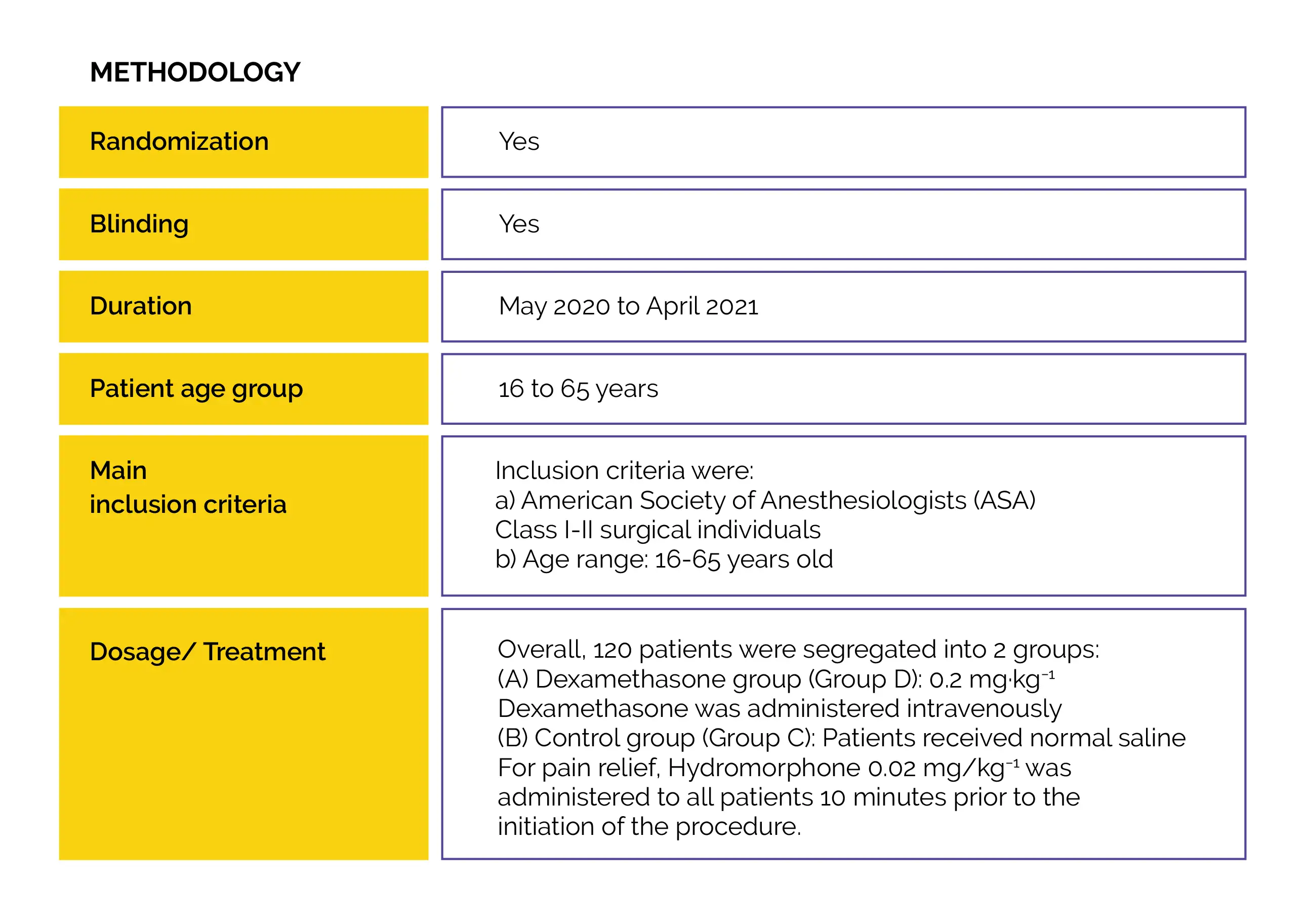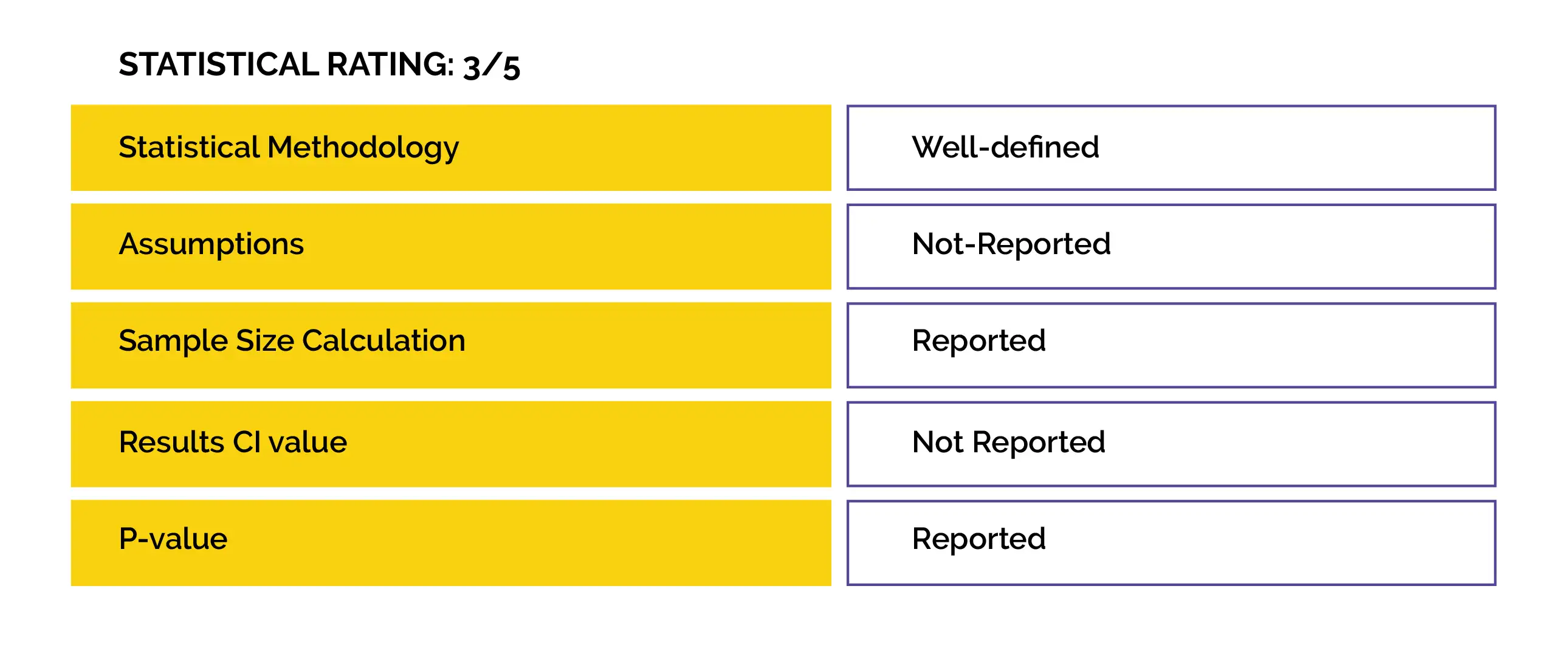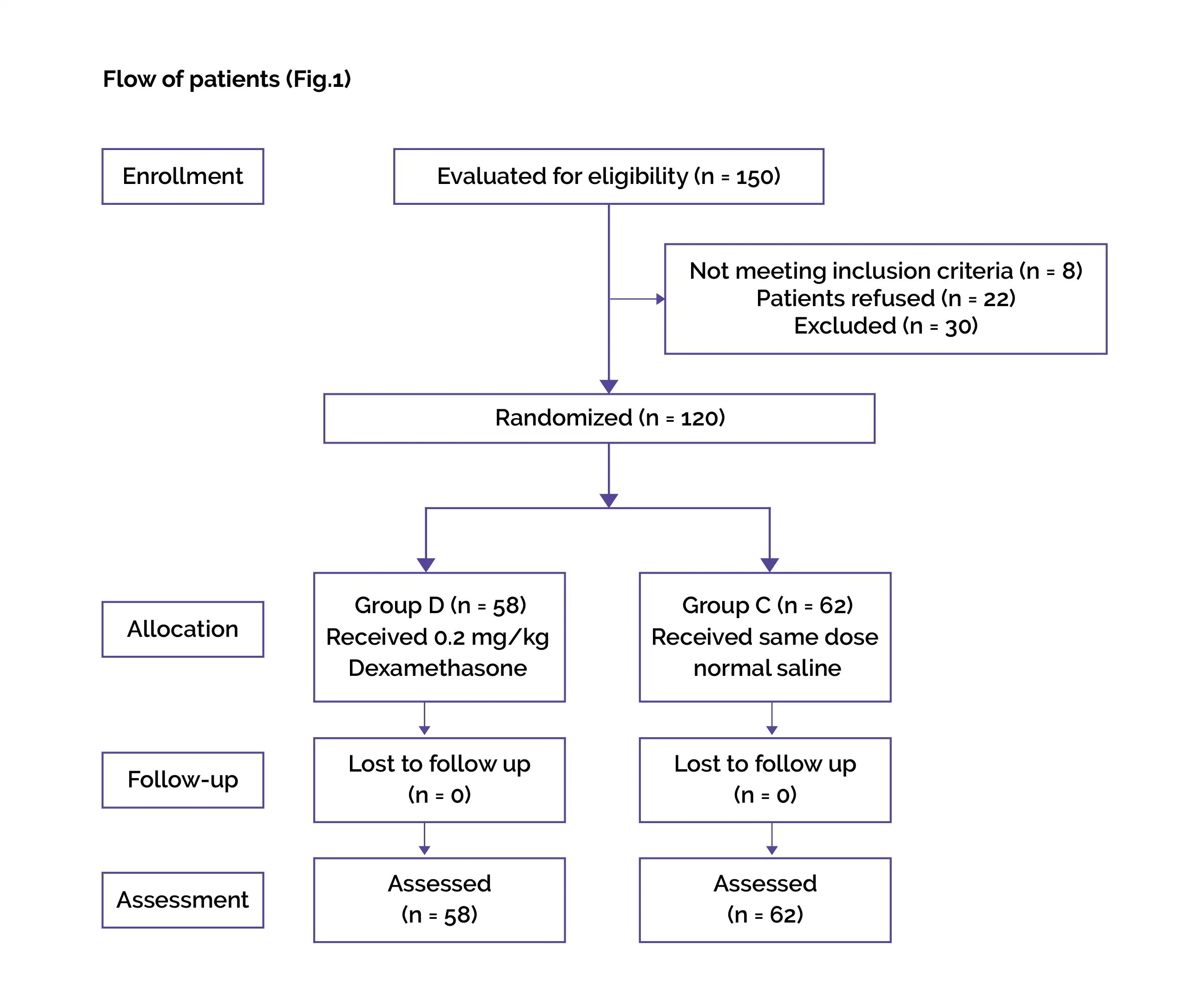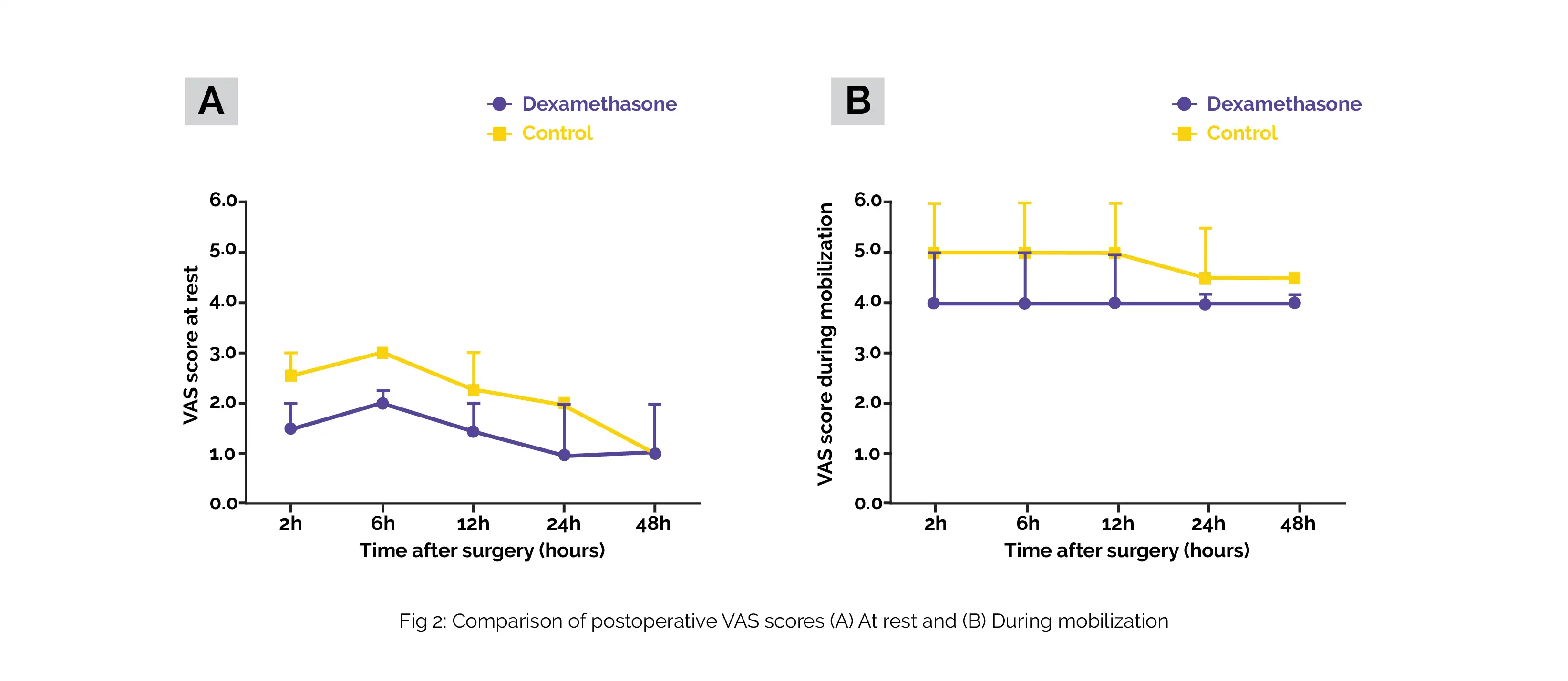Categories
Change Password!
Reset Password!


One of the most frequent procedures in oral surgery is the enucleation of jaw cysts.
Preoperative use of intravenous Dexamethasone dramatically reduced postoperative pain, trismus, and edema while improving the analgesic effect of hydromorphone after jaw cyst surgery.
One of the most frequent procedures in oral surgery is the enucleation of jaw cysts. Owing to the requirement for injuring the soft tissues of the oral cavity and removing bone tissue, a substantial amount of postoperative inflammation occurs. This inflammation is frequently accompanied by moderate to severe pain, edema, and trismus, all of which exacerbate the discomfort and pain of the patient.
Controlling postoperative inflammation, majorly swelling and pain, has become more crucial because of the requirement for a comfortable postsurgical recovery and a prompt resumption to daily activities. This has led to oral surgery being regarded as the gold standard and a good model in pain trials. Preventive analgesia techniques are frequently employed in clinical anesthesia in order to reduce the likelihood of transforming chronic pain in the long run as well as the accompanying acute postsurgical pain.
In anesthesia, Dexamethasone is frequently employed as an adjuvant to anesthetic analgesia to increase the duration and impact of postsurgical analgesia and to decrease the usage of postsurgical analgesics. It is also commonly used in oral surgery to avoid postsurgical complications.
RATIONALE BEHIND RESEARCH
Dexamethasone is extensively utilized to prevent postsurgery complications in oral surgery and boost the analgesic effectiveness after anesthesia. But, the efficacy is controversial, and the association between postsurgery complications and pain is still not clear. Fewer trials have examined the link between postsurgical complications and pain, and the effectiveness is uncertain and debatable.
This randomized, prospective, double-blind study was therefore conducted to explore Dexamethasone's effectiveness in postoperative analgesia and prevention of postsurgical complications in jaw cyst surgery.
OBJECTIVE
A randomized controlled study was conducted to examine the link between postoperative complications and pain as well as the analgesic impact of Dexamethasone in the management of jaw cysts.


Study outcomes

Outcomes
Baseline: No vital differences were reported at baseline.
Study outcomes

In line with the other trials, preoperative intravenous Dexamethasone remarkably reduced postsurgical pain and increased the analgesic impact of Hydromorphone. The mechanisms incorporating gene regulation, a reduction in endotoxin levels, or immunosuppression, by which Dexamethasone decreases postsurgical pain remain unclear despite a large number of conclusive findings and related studies. However, the majority of studies indicate that it is inextricably associated with Dexamethasone's potent anti-inflammatory effects.
Microglia and other secreted inflammatory factors play a significant role in pain generation and progression. Dexamethasone suppresses microglial activation and morphological changes at 0.5 hours after tissue damage. The current study's findings demonstrated that the treatment group's incidence of painful events and pain intensity considerably declined from 2 hours following surgery, indicating that the subjects receiving Dexamethasone experienced significantly less postsurgical pain. Following oral surgery, trismus and facial swelling are frequent postoperative consequences.
Swelling and difficulties in opening the mouth are stimulated by elevated capillary permeability triggered by persistent postsurgery inflammation. This, in turn, induces cellular and tissue edema.
According to a study conducted by Falci, Dexamethasone was superior to Methylprednisolone in managing postoperative trismus and swelling, and it prevented postsurgical sequelae better than NSAIDs did.
In accordance with the findings of the current study, subjects in the Dexamethasone group began to exhibit light trismus and facial swelling contrasted with the control group 24 hours post surgery, and these variations became more prominent 48 hours later. A study from Korea discovered that the greatest face swelling that appears after oral surgery occurs 2.25 ± 0.19 days following surgery. As a result, a profound variation at 6 and 12 hours after surgery between both groups was not recorded since it was too early for the difference to appear.
The association between facial swelling and postoperative pain at 48 hours after operation was not documented since the severity of the pain started to subside 24 hours post-surgery after many procedures. But, the results of the current study indicated that there is a significant link between them during mobilization and at rest at all other time points postsurgically, as per the analysis of overall samples. The sensitive indicator and marker CRP was used to reflect several infectious and non-infectious systemic inflammation.
The amount of serum CRP was found to be strongly connected with pain intensity, as well as to the development and prognosis of the illness, in the trial of osteoarthritis and knee arthritis models. Volunteers in the Dexamethasone group had substantially reduced serum CRP levels when compared to those in the control group. This finding is in line with those of Tammachote and Kim, both of which illustrated that Dexamethasone plays a significant role in the development of inflammation and preventing the production of postsurgical inflammatory factors.
Postoperative inflammation leading to face swelling can additionally cause symptoms like trismus. These symptoms can considerably intensify the patient's postsurgical discomfort and pain.
However, Dexamethasone use inhibits this process. The development of postsurgical complications and inflammation are suppressed by Dexamethasone, which in turn minimizes postoperative pain development.
The utilization of glucocorticoids was deemed to have side effects including delayed surgical wound healing and hyperglycemia. The findings of the study indicated that concentrations of blood glucose were raised to various extents in both groups at 24 hours following surgery, but there was no variation between the control group and the Dexamethasone group. In the current study, the occurrence of a stressful rise in blood glucose was related to anesthesia and surgery in the specific situation instead of the impact of Dexamethasone.
In light of this, there are evidences to suggest that perioperative intravenous therapy with 0.2 mg/kg−1 of Dexamethasone is safe. Dexamethasone in preventive analgesia mitigates pain and complications after jaw cyst enucleation. In order to obtain the most precise clinical data, the study's next step would be to establish routine postoperative follow-ups to prolong the observation of the development of postoperative problems in patients.
By preventing inflammation production, Dexamethasone is effective to lessen the severity of trismus, postoperative pain, and facial edema following jaw cyst surgery.
BMC Anesthesiology
Dexamethasone in preventive analgesia alleviates pain and complications after jaw cyst enucleation: a randomized controlled trial
Wang Zhou et al.
Comments (0)